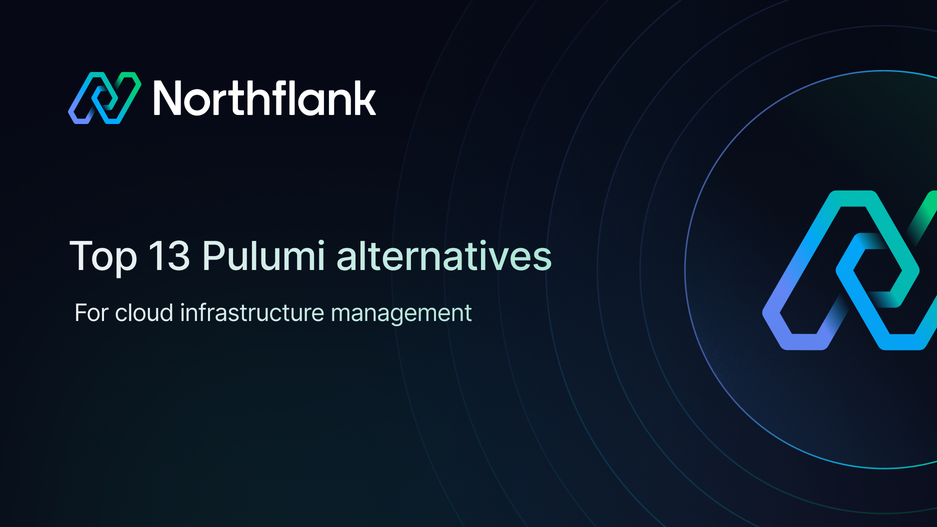

Top 13 Pulumi alternatives in 2025
Pulumi alternatives range from traditional Infrastructure as Code (IaC) tools to complete platform solutions that handle infrastructure, deployment, and operations together. Here are the top options:
- Northflank - Kubernetes-native platform with Bring Your Own Cloud (BYOC) support (deploy in your own AWS, Azure, GCP, Civo, Oracle, or bare-metal/on-premise), integrated CI/CD, databases, and zero vendor lock-in. Complete deployment solution beyond infrastructure provisioning.
- Terraform - IaC tool using HCL language with large ecosystem, though now under Business Source License.
- OpenTofu - Open-source Terraform fork under Linux Foundation with full Terraform compatibility and community governance.
- AWS CDK - Code infrastructure for AWS using TypeScript, Python, or other languages, but AWS-only.
- Crossplane - Kubernetes-native IaC using CRDs and GitOps workflows for teams already running Kubernetes.
- Ansible - Agentless automation using YAML playbooks, better for configuration management than complex infrastructure.
- Azure Bicep - Modern DSL for Azure resources, cleaner than ARM templates but Azure-specific.
- CDK for Terraform - Write Terraform infrastructure in programming languages instead of HCL.
- AWS CloudFormation - AWS-native templates in YAML/JSON with deep service integration.
- Azure ARM Templates - Microsoft's JSON-based IaC for Azure (Bicep is recommended modern alternative).
- Chef - Ruby-based configuration management for traditional infrastructure.
- Puppet - Declarative configuration management with agent-based architecture.
- Vagrant - Tool for building and managing virtualized development environments with simple configuration.
When evaluating alternatives to Pulumi, look out for these factors based on common pain points teams experience:
- Do I need more than just infrastructure provisioning? If you're looking for a complete platform that handles deployment, CI/CD, databases, and operations alongside infrastructure management, look out for platforms rather than point tools.
- How important is keeping data within my security boundary? For regulated industries requiring strict data residency and compliance controls, look for solutions with built-in Bring Your Own Cloud (BYOC) capabilities rather than SaaS-only state management.
- What's my team's technical background? Developer-heavy teams may prefer programming languages, while operations-focused teams often work better with declarative DSLs or managed platforms.
- Can I avoid vendor lock-in? Check whether the tool uses open standards like Kubernetes and Docker, or proprietary SDKs and languages that make migration difficult.
- What are the total costs at scale? Look beyond free tiers and understand pricing models based on resources, users, or compute usage to avoid surprises as you grow.
- Will this tool grow with my team? Check if the solution supports multi-cloud deployments, handles increasing complexity, and provides the right level of abstraction for your current and future needs
These alternatives fall into three categories: complete platforms that handle more than just provisioning, multi-cloud IaC tools, and cloud-specific solutions.
Best for: Teams needing a complete deployment platform with features to help meet compliance standards (Bring Your Own Cloud (BYOC)), CI/CD pipelines, managed databases, multi-cloud support, and zero vendor lock-in, all without infrastructure complexity
Northflank takes a different approach than traditional IaC tools by providing a complete platform for deploying and operating applications, beyond provisioning infrastructure. Built on standard Kubernetes, it abstracts complexity while maintaining portability.
The platform's Bring Your Own Cloud model addresses compliance requirements by keeping all runtime, data, and logs within your cloud boundary across AWS, GCP, Azure, Civo, Oracle, or on-premise/bare-metal.
Because Northflank runs on standard Kubernetes and Docker, you avoid vendor lock-in. Your applications remain portable and can be exported to run on any Kubernetes cluster. This contrasts with tools that use proprietary SDKs or domain-specific languages, which require code rewrites for migration.

Key capabilities:
- Infrastructure as code using templates with bidirectional GitOps
- Built-in CI/CD pipelines and preview environments
- Managed databases (PostgreSQL, MongoDB, MySQL, Redis)
- Real-time logs and metrics
- GPU workload support for AI/ML applications
- Multi-cloud deployment with unified interface
- Usage-based pricing per compute resources, not per resource count
Teams like Weights have scaled to millions of users running 10,000+ AI training jobs daily with minimal infrastructure overhead using this approach.
Northflank works well for developer teams wanting to ship applications quickly, organizations with strict compliance requirements, and companies running workloads or AI/ML applications (both CPU & GPU) across multiple clouds.
Pricing: Free developer tier, usage-based pricing for production workloads
Best for: Organizations using HCL-based infrastructure automation
Terraform uses HashiCorp Configuration Language (HCL) to define infrastructure across multiple cloud providers. The 2023 license change to Business Source License means it's no longer fully open-source, creating restrictions for some commercial use cases.

Key features:
- Declarative HCL syntax
- Execution planning (terraform plan)
- Multi-cloud provider support
- Module registry with community contributions
- State management with remote backends
- Infrastructure drift detection
License: Business Source License v1.1
Best for: Teams wanting fully open-source Terraform compatibility
OpenTofu is a community fork of Terraform governed by the Linux Foundation, maintaining full compatibility with Terraform configurations while remaining open-source. Built-in state encryption adds security without external tools.
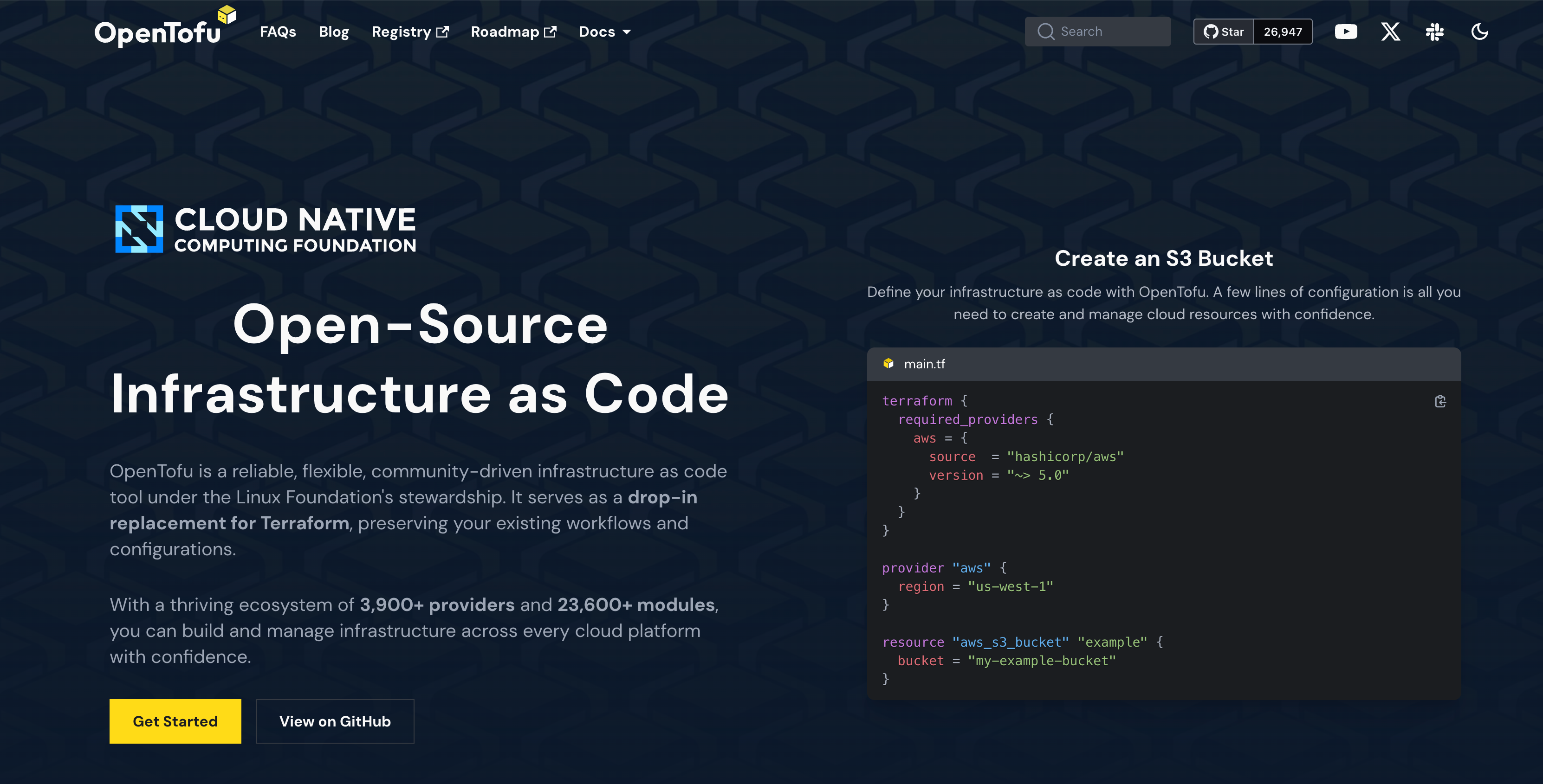
Key features:
- Full Terraform compatibility
- Community governance under Linux Foundation
- Built-in state encryption
- Enhanced security features
- Access to 3,900+ providers and 23,600+ modules
- Advanced workflow capabilities
License: Mozilla Public License v2.0
Best for: AWS-native applications using programming languages
AWS Cloud Development Kit lets developers define AWS infrastructure using TypeScript, Python, Java, C#, or Go. Code synthesizes into CloudFormation templates for deployment, limited to AWS only.

Key features:
- Multiple language support (TypeScript, Python, Java, C#, Go)
- Construct library (L1-L3 abstractions)
- Automatic synthesis to CloudFormation
- Native AWS service integration
- Built-in testing support
- IDE integration with autocomplete and type checking
License: Apache License 2.0
Best for: Platform teams managing infrastructure through Kubernetes
Crossplane extends Kubernetes to manage cloud infrastructure using Custom Resource Definitions. Platform engineers can define custom infrastructure APIs for developers to consume.

Key features:
- Kubernetes-native design (infrastructure as CRDs)
- GitOps compatible
- Custom infrastructure APIs through compositions
- Multi-cloud support (AWS, Azure, GCP, Alibaba Cloud)
- Declarative configuration
- Separation of concerns between platform and developers
License: Apache License 2.0
Best for: Agentless automation and configuration tasks
Ansible uses YAML playbooks for automation without requiring agent installation on managed nodes. Procedural execution and less sophisticated state management make it less suitable for complex infrastructure compared to tools purpose-built for IaC.

Key features:
- Agentless architecture (SSH/WinRM)
- YAML-based playbooks
- Wide ecosystem of modules
- Procedural execution model
- Simple learning curve
- Orchestration capabilities
License: GNU GPL v3.0
Best for: Azure deployments needing cleaner syntax than ARM templates
Microsoft developed Bicep to address ARM template verbosity, transpiling to ARM JSON at runtime. Limited to Azure infrastructure only.
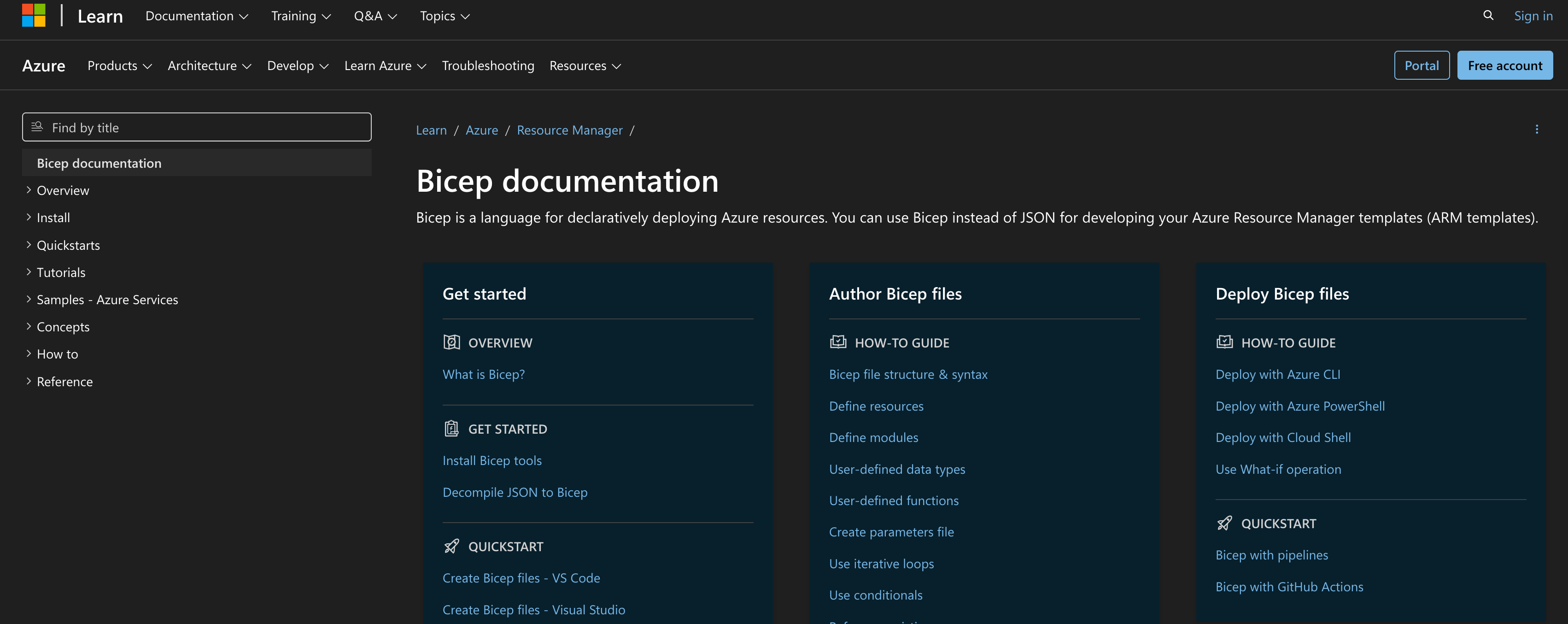
Key features:
- Concise, human-readable syntax
- Full ARM template compatibility
- Native Azure support with same-day feature access
- Built-in IDE tooling and validation
- Modular and reusable design
- Type safety and IntelliSense support
License: MIT License
Best for: Developers wanting Terraform providers with programming languages
CDKTF combines Terraform's provider ecosystem with code-based infrastructure definitions in TypeScript, Python, Java, C#, or Go. Code compiles into standard Terraform JSON, maintaining compatibility with Terraform workflows.

Key features:
- Multiple language support (TypeScript, Python, Java, C#, Go)
- Terraform compatibility and provider ecosystem
- Type safety and IDE integration
- Programming language constructs (loops, conditionals, functions)
- Compiles to standard Terraform JSON
- Access to Terraform modules
License: Mozilla Public License v2.0
Best for: AWS-only infrastructure with native service integration
CloudFormation is AWS's native IaC using YAML or JSON templates with first-party support for AWS services. Templates can be verbose and lack programming constructs.

Key features:
- AWS-native with first-party support
- Declarative templates in YAML/JSON
- Automatic dependency resolution
- Change sets for preview
- Drift detection
- Stack management and rollback capabilities
License: Proprietary (free to use)
Best for: Legacy Azure deployments (Bicep now recommended)
ARM Templates define Azure infrastructure using JSON with native platform integration. Microsoft now recommends Bicep for new deployments due to ARM's verbose syntax.
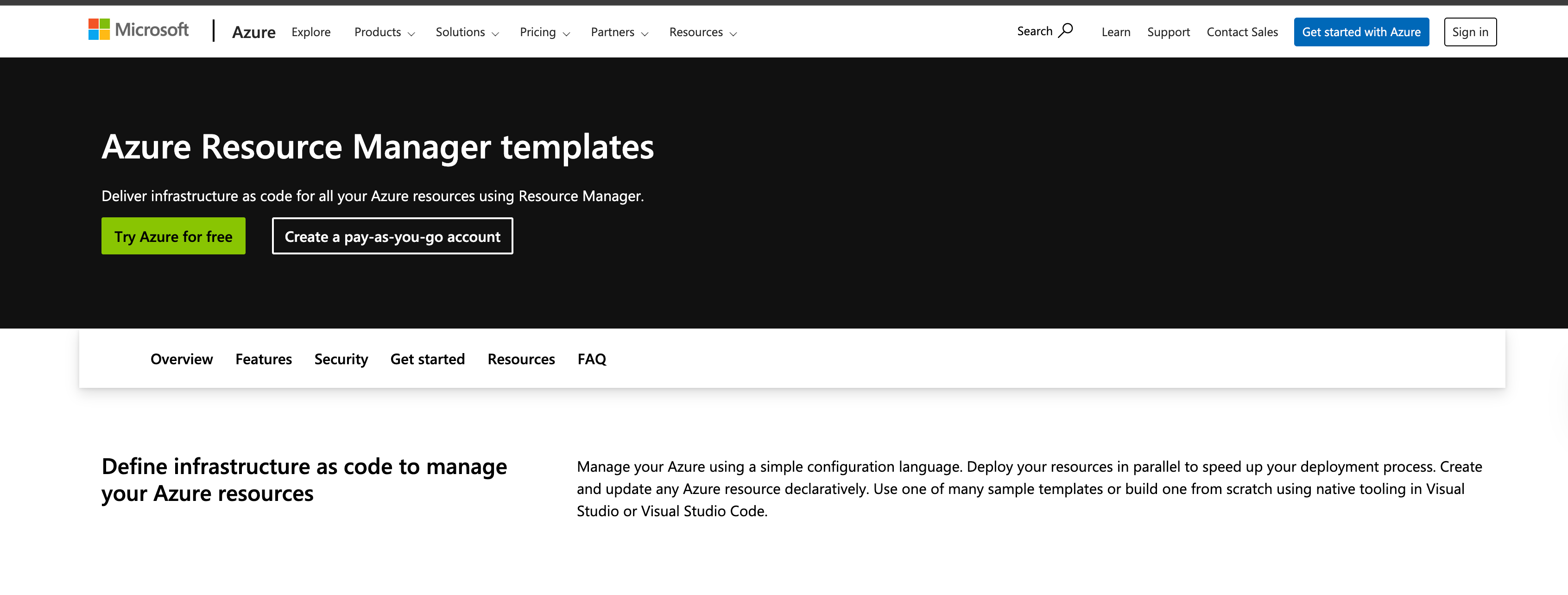
Key features:
- Native Azure integration
- JSON-based declarative syntax
- Idempotent deployments
- Integration with Azure policies and RBAC
- Template validation and what-if analysis
- Secure parameter handling
License: Proprietary
Best for: Traditional infrastructure configuration
Chef automates infrastructure setup using Ruby-based DSL with procedural and imperative approaches. Requires Ruby knowledge and uses agent-based architecture.

Key features:
- Ruby-based DSL
- Procedural and imperative approach
- Agent-based architecture
- Configuration enforcement
- Test-driven infrastructure development
- Cookbook sharing and reuse
License: Apache License 2.0
Best for: Large-scale server configuration
Puppet enforces system configuration using declarative language and agent-master architecture. Designed for consistent configuration across server fleets rather than cloud provisioning.

Key features:
- Declarative configuration model
- Agent-master architecture
- State enforcement and drift correction
- Module ecosystem (Puppet Forge)
- Reporting and compliance tracking
- Multi-platform support
License: Apache License 2.0
Best for: Creating consistent development environments
Vagrant simplifies creating and managing virtualized development environments using simple configuration files. Works with providers like VirtualBox, VMware, and Docker.
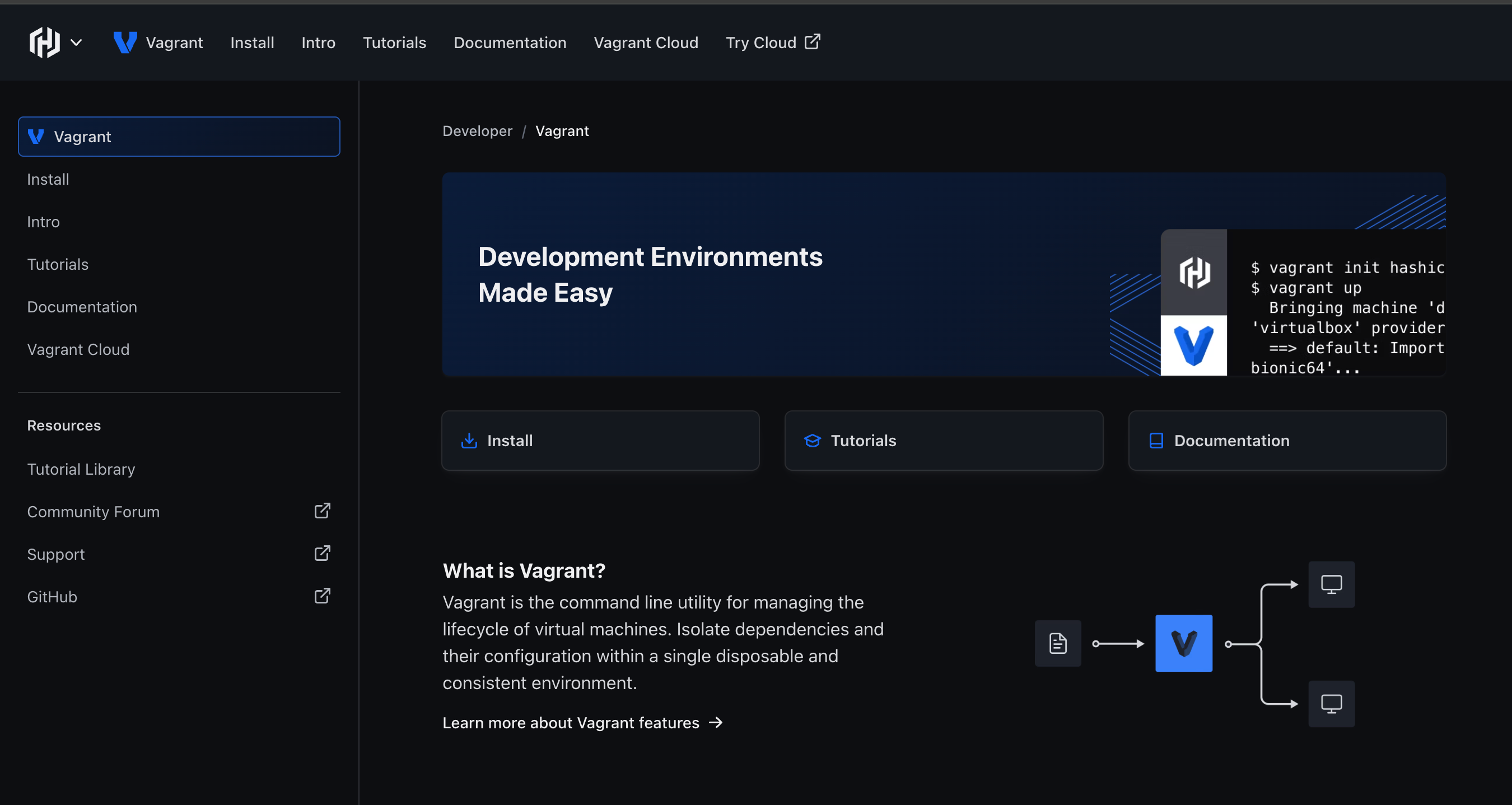
Key features:
- Simple configuration files (Vagrantfile)
- Multiple provider support (VirtualBox, VMware, Docker)
- Environment consistency across teams
- Plugin ecosystem
- Provisioning integration with Ansible, Chef, Puppet
- Box sharing and distribution
License: MIT License
This comparison helps you quickly identify which tools match your specific requirements and team structure.
| If you need... | Consider... | Because... |
|---|---|---|
| Deployment + operations + infrastructure in one platform | Northflank | Handles complete application lifecycle beyond provisioning |
| Strict compliance with data residency requirements | Northflank (BYOC), self-hosted OpenTofu | Keeps all data within your security boundary |
| Mature ecosystem with extensive community modules | Terraform, OpenTofu | Largest collection of providers and pre-built modules |
| Zero vendor lock-in with open standards | Northflank, OpenTofu, Crossplane | Built on Kubernetes, Docker, or open-source foundations |
| AWS-specific infrastructure with programming languages | AWS CDK | Native AWS integration with TypeScript, Python, Java support |
| Multi-cloud without proprietary lock-in | OpenTofu, Northflank | Works across clouds with portable configurations |
| GitOps-native Kubernetes infrastructure | Crossplane | Treats infrastructure as Kubernetes resources |
| Simple configuration management | Ansible | Agentless with straightforward YAML syntax |
| Azure-native with modern syntax | Bicep | Cleaner than ARM templates with same-day feature support |
| Transparent usage-based pricing | Northflank | Pay for compute resources used, not resource counts |
The best alternative depends on your team's needs, technical background, and infrastructure requirements. Traditional IaC tools like Terraform and OpenTofu work well for infrastructure provisioning when you have dedicated DevOps resources. Cloud-specific tools like AWS CDK or Azure Bicep make sense for single-cloud deployments.
If you need more than just infrastructure provisioning, such as deployment pipelines, runtime operations, compliance controls, and developer self-service, platforms like Northflank provide integrated solutions without forcing you into proprietary lock-in.
Try Northflank's free developer sandbox to see how it compares with your current setup, or book a demo with an engineer to discuss your specific requirements.